Overview
The article titled "18 Campaigns Examples That Transformed Branding Strategies" addresses a common challenge faced by many brands: the struggle to connect with consumers in a meaningful way. This disconnect can lead to lost opportunities and diminished loyalty, leaving brands feeling isolated in a crowded marketplace. However, by exploring successful marketing campaigns like Dove's Real Beauty and Nike's Just Do It, we can see how innovative, purpose-driven marketing can bridge this gap. These campaigns not only enhance brand loyalty but also foster emotional connections that resonate deeply with consumers.
In today's fast-paced world, authenticity and consumer engagement are more important than ever. Brands that embrace these principles can experience substantial sales growth and create lasting relationships with their audiences. This article serves as a reminder that by prioritizing empathy and understanding in branding strategies, companies can transform their approach and find success. Together, let’s explore how these inspiring examples can guide us toward a more compassionate and effective branding journey.
Introduction
In the competitive landscape of branding, many brands face the challenge of connecting authentically with consumers. This struggle can lead to a sense of disconnection, leaving both brands and their audiences feeling unheard. The article explores 18 transformative campaigns that not only redefined marketing strategies but also left an indelible mark on brand perception and consumer loyalty.
From Dove's groundbreaking approach to beauty standards to Patagonia's call for sustainability, these examples illustrate how innovative thinking and emotional resonance can drive success. Yet, as brands navigate the complexities of modern marketing, one question arises: how can they continue to evolve and engage their audiences in a meaningful way?
This inquiry invites us to reflect on our own experiences and consider the nurturing connections we can foster within our communities.
RNO1: Revolutionize Your Brand with Innovative Digital Experiences
In today's fast-paced digital world, many companies struggle to create meaningful connections with their audiences. This challenge can lead to feelings of frustration and uncertainty, especially as they navigate the complexities of marketing and digital growth. RNO1 understands these pain points and stands ready to help. By specializing in radical digital experiences tailored for modern businesses, they offer innovative solutions like subscription models—Revolve, Retrn, and Ryde—that empower companies across various sectors to achieve sustainable growth. With Revolve's dynamic content delivery, Retrn's focus on customer feedback integration, and Ryde's enhancement of user engagement through personalized experiences, RNO1 ensures that companies can forge deeper connections with their customers.
The impact of subscription models on branding strategies is profound and cannot be understated. Businesses embracing these models often see customer retention rates soar to as high as 90%, a stark contrast to the standard 30-40% retention rates typical in traditional e-commerce. This shift not only fosters customer loyalty but also provides companies with reliable revenue streams, nurturing long-term relationships with their clients.
As the digital landscape continues to evolve, RNO1 remains dedicated to staying ahead of the latest trends in digital experiences. Their emphasis on personalization and community involvement reflects the growing demand for customized interactions. Experts in the field emphasize that authenticity and emotional connections are vital for success in this competitive environment. By incorporating innovative digital solutions, RNO1 helps companies not just meet but exceed consumer expectations, positioning them for success in an ever-changing market. To truly , companies should continuously analyze customer feedback and adapt their offerings, enhancing engagement and retention in a way that resonates with their audience.
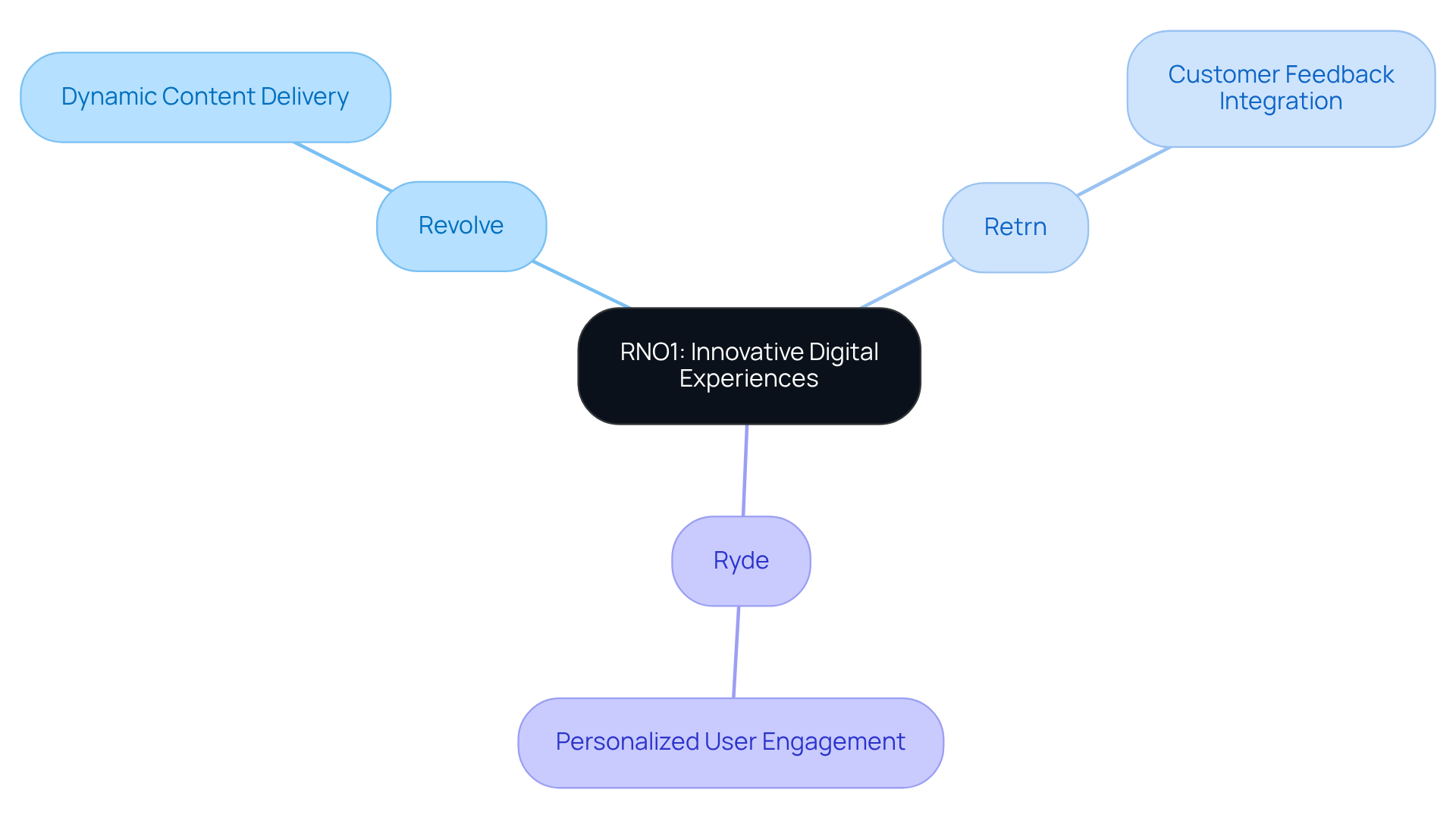
Dove: Real Beauty Campaign That Redefined Beauty Standards
Dove's Real Beauty initiative, launched in 2004, is one of the notable campaign examples that addressed a significant issue in the beauty industry: the narrow standards of beauty that often leave many feeling excluded. By showcasing authentic women of diverse shapes, sizes, and backgrounds, Dove challenged these traditional norms, resonating deeply with consumers. This approach not only fostered a sense of belonging but also significantly enhanced , with 71% of women reporting a more favorable perception of Dove due to this initiative.
The impact was profound, as Dove's sales soared from $2.5 billion to over $4 billion within the initial three years, illustrating the financial success of this compassionate approach. The campaign's triumph lies in its ability to cultivate community and empowerment, encouraging women to embrace their natural beauty and share their personal stories. By prioritizing authenticity, Dove has not only redefined its identity but has also set a new standard for the beauty industry, using campaign examples to spark important conversations around inclusivity and self-acceptance.
Experts emphasize that authenticity in branding is crucial as we approach 2025, with consumers increasingly seeking brands that align with their values and experiences. The initiative also achieved an impressive 700% increase in social media engagement, showcasing its effectiveness in building connections. Dove's ongoing commitment to real beauty continues to inspire campaign examples across the industry, highlighting the transformative power of purpose-driven marketing in shaping consumer perceptions and driving sales.
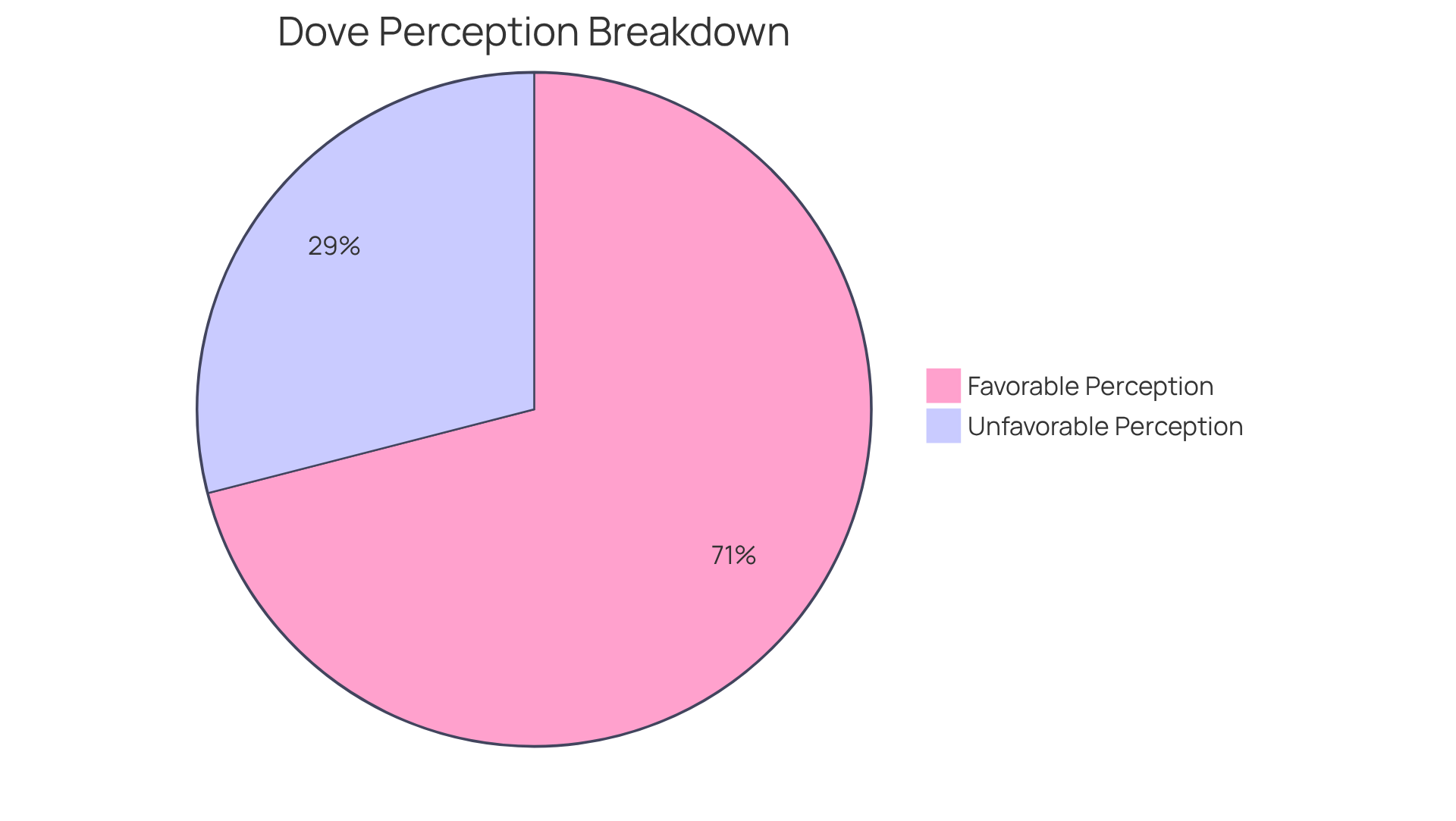
Nike: Just Do It Campaign That Inspires Action and Loyalty
Nike's 'Just Do It' initiative, which began in 1988, has become more than just a marketing campaign; it has evolved into a cultural phenomenon that speaks to our shared need for motivation and empowerment. This iconic slogan encourages each of us to and chase our dreams, no matter the challenges we encounter along the way.
Over the years, Nike has skillfully adapted this message, ensuring it resonates with different generations and remains relevant in an ever-evolving market landscape. The emotional depth of this campaign has not only cultivated a dedicated customer base but has also established a standard for effective branding strategies, as seen in various campaign examples across different industries.
Nike has created campaign examples that connect with universal themes of perseverance and achievement, inspiring consumers to see their products as essential companions on their path to greatness. This emotional bond is invaluable; studies indicate that customers who feel emotionally engaged are far more likely to stay loyal and advocate for the brand, ultimately fostering sustainable growth and strengthening Nike's position in the market.
Remarkably, Nike's global sales surged from $877 million to $9.2 billion within the first ten years of launching the 'Just Do It' initiative, and its share of the North American athletic footwear market grew from 18% to 43%. Dan Wieden highlighted the importance of crafting a tagline that resonates with both dedicated athletes and casual fitness enthusiasts, a factor that has broadened its appeal.
The cultural significance of this initiative has granted Nike unique and enduring market value, solidifying its role as a leader in the sportswear industry.
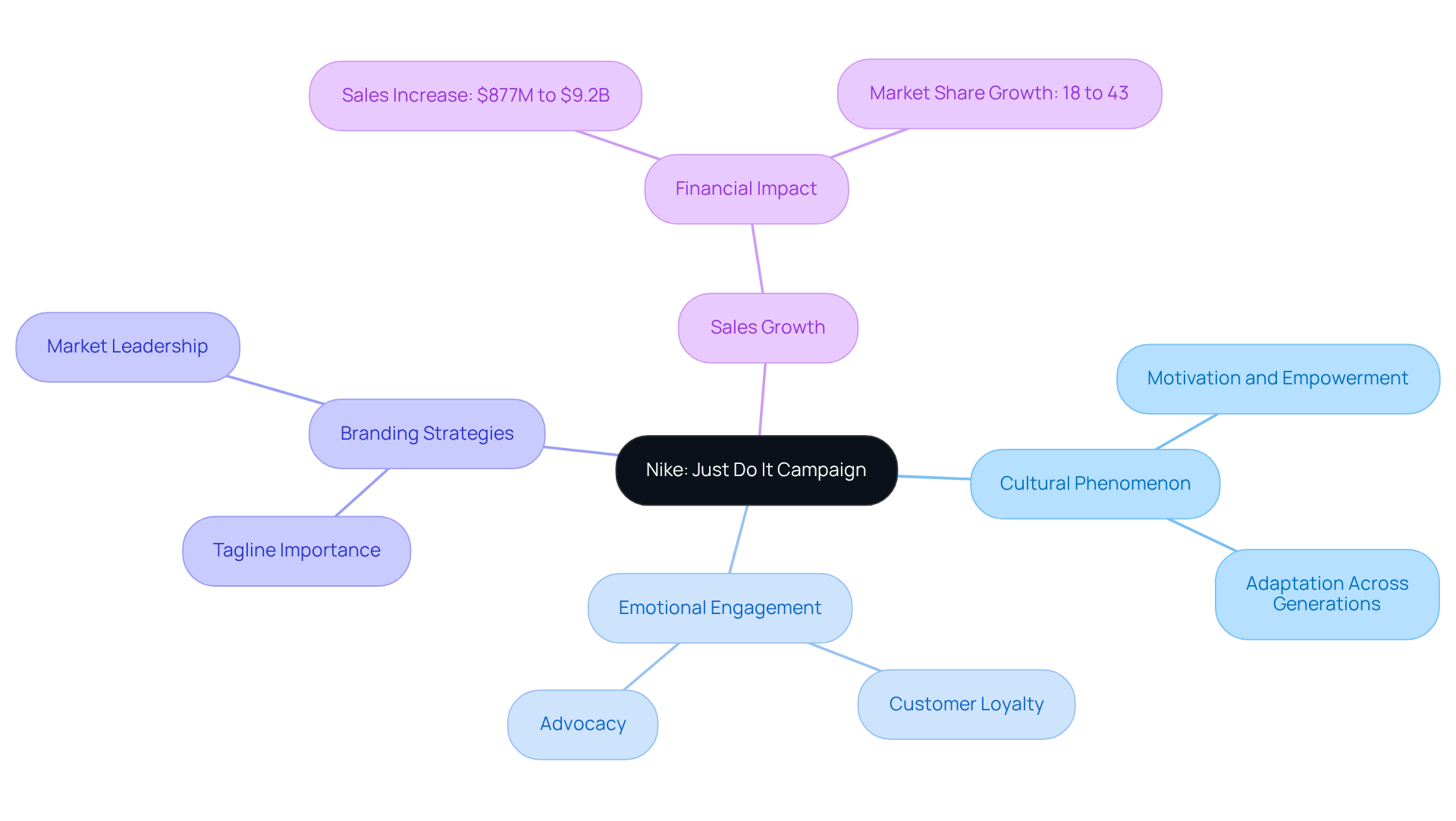
Coca-Cola: Share a Coke Campaign That Personalizes Customer Engagement
Coca-Cola's 'Share a Coke' initiative, launched in 2011, addressed a common challenge in brand interaction: the feeling of disconnection. By replacing its iconic logo with popular names on bottles, Coca-Cola encouraged individuals to discover and share a Coke with friends and family, nurturing a sense of personal connection. This clever strategy sparked a social media phenomenon, with over 500,000 photos shared under the hashtag #ShareaCoke, generating an impressive 998 million impressions on Twitter. The emotional resonance of seeing one's name on a product created a strong bond between buyers and the company, leading to a 2% increase in U.S. sales after a decade of decline. This initiative not only showcased the power of personalization in marketing but also highlighted the importance of making individuals feel seen and valued.
As industry experts note, personalization has become essential for brands today, with Coca-Cola's initiative serving as a heartwarming campaigns example of how to forge meaningful connections that inspire engagement and loyalty. We can all learn from this approach, recognizing the profound impact that a simple gesture can have on .
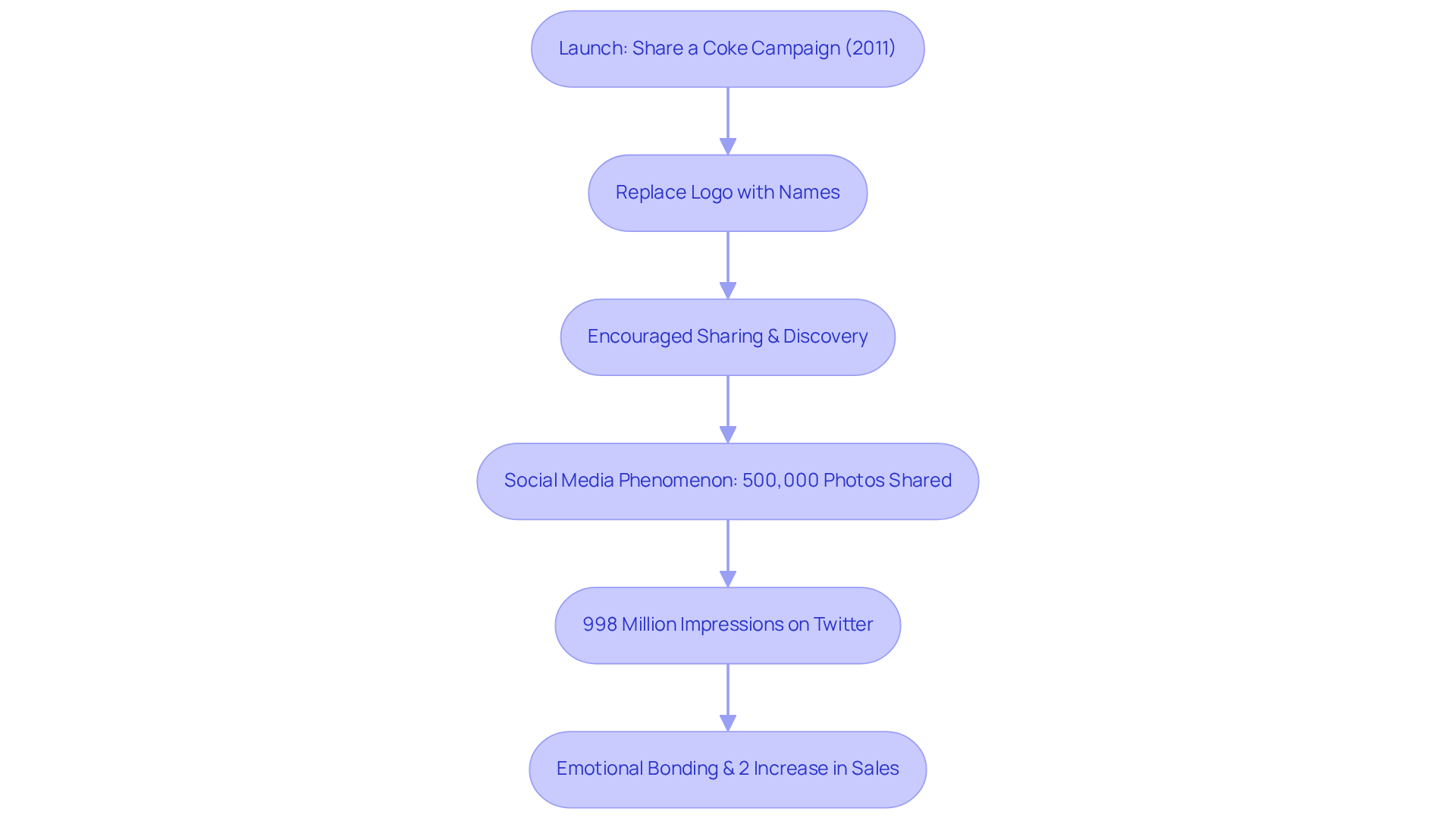
Old Spice: The Man Your Man Could Smell Like Campaign That Captivated Audiences
Old Spice's 'The Man Your Man Could Smell Like' initiative, launched on February 4th, 2010, addressed a common concern: the perception of grooming products as outdated and unappealing. This clever campaign's examples masterfully employed humor and absurdity to engage consumers, particularly targeting women, who often influence men's grooming product purchases.
Featuring the charismatic Isaiah Mustafa, the advertisements showcased dramatized conversations between couples about pleasantly scented body wash, creating an inviting narrative that quickly went viral. It garnered over 1.4 billion impressions, leading to a remarkable 107% increase in sales, with body wash sales doubling.
This bold rebranding effort not only revitalized Old Spice's image from a 'dad product' to a modern, desirable option but also illustrated the power of creativity in marketing. The success of this initiative serves as a testament to how campaign examples that understand audience dynamics and utilize humor can transform brand perception and foster significant growth.
As Sarah Rowe observed, 'The outcome of the initiative was phenomenal; it is the fastest growing and most popular interactive effort in history.' This story reminds us that with the right approach, change is not just possible, but can lead to .
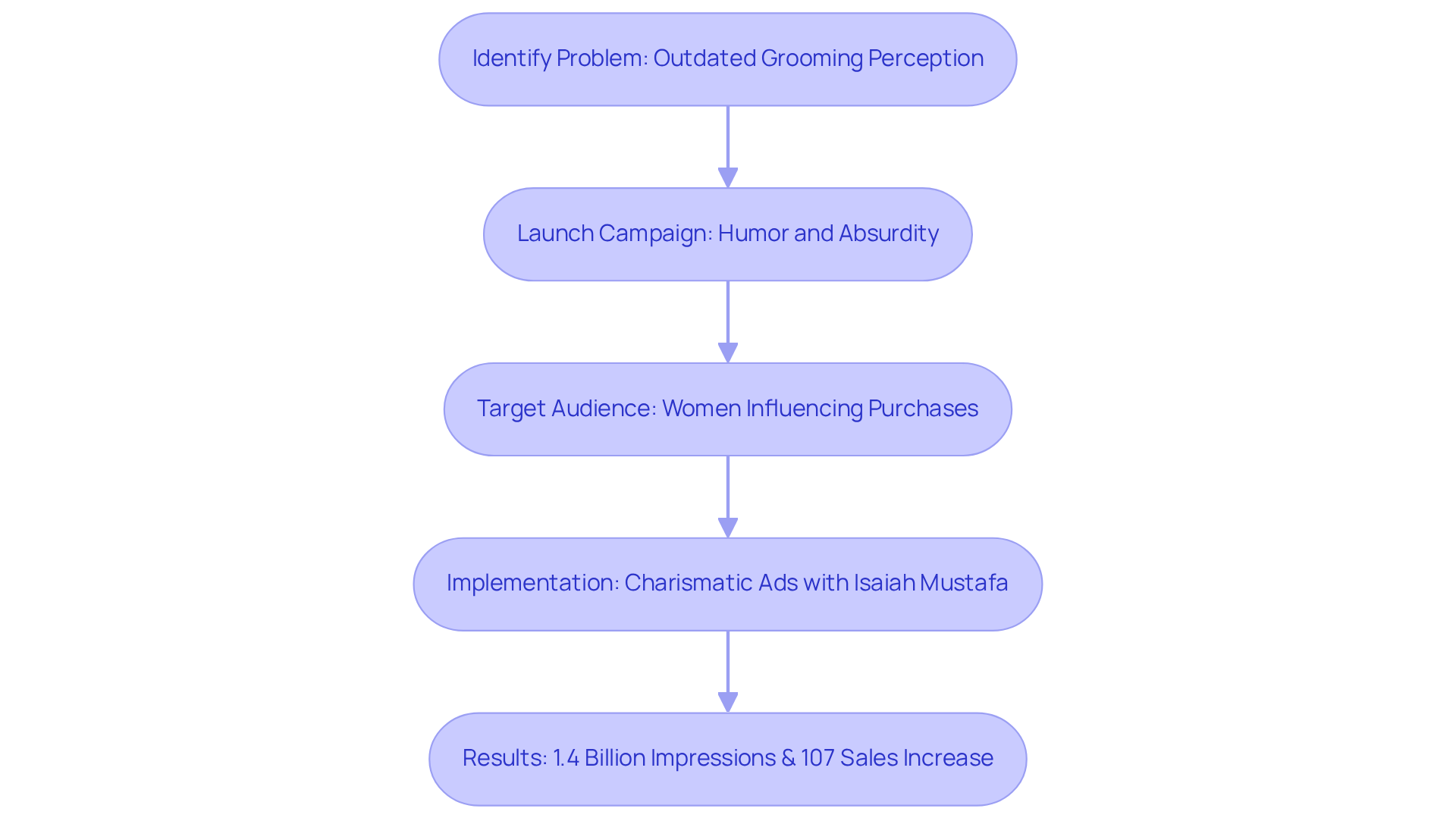
California Milk Processor Board: Got Milk? Campaign That Created Cultural Impact
Launched in 1993, the 'Got Milk?' initiative emerged as a cultural phenomenon, tapping into humor and relatable scenarios to reshape how we think about milk consumption. By showcasing stars adorned with iconic milk mustaches, it not only boosted milk's visibility but also highlighted its nutritional benefits. This clever use of humor resonated deeply with audiences, making the tagline memorable and creating a lasting presence in American advertising. It serves as a reminder of how effective messaging can transform branding strategies, illustrating that thoughtful humor can significantly enhance customer engagement and brand loyalty.
As we navigate the evolving landscape of advertising, the legacy of 'Got Milk?' stands as a testament to the enduring power of storytelling and humor in influencing our purchasing decisions. Importantly, the initiative aimed to redefine what is considered cool, making milk memorable for new generations. It adapted to changing consumer preferences by featuring everyday individuals instead of celebrities for the first time in 30 years, fostering a sense of community.
Despite its popularity, the initiative faced challenges, including the rise of non-dairy alternatives and shifting lifestyle trends that impacted milk consumption. The first 'Got Milk?' advertisement aired in 1993, and during its run, over 12,000 portraits were captured, showcasing its extensive reach and cultural impact. This journey reminds us of the , encouraging us to reflect on our own experiences with products that resonate with our lives.
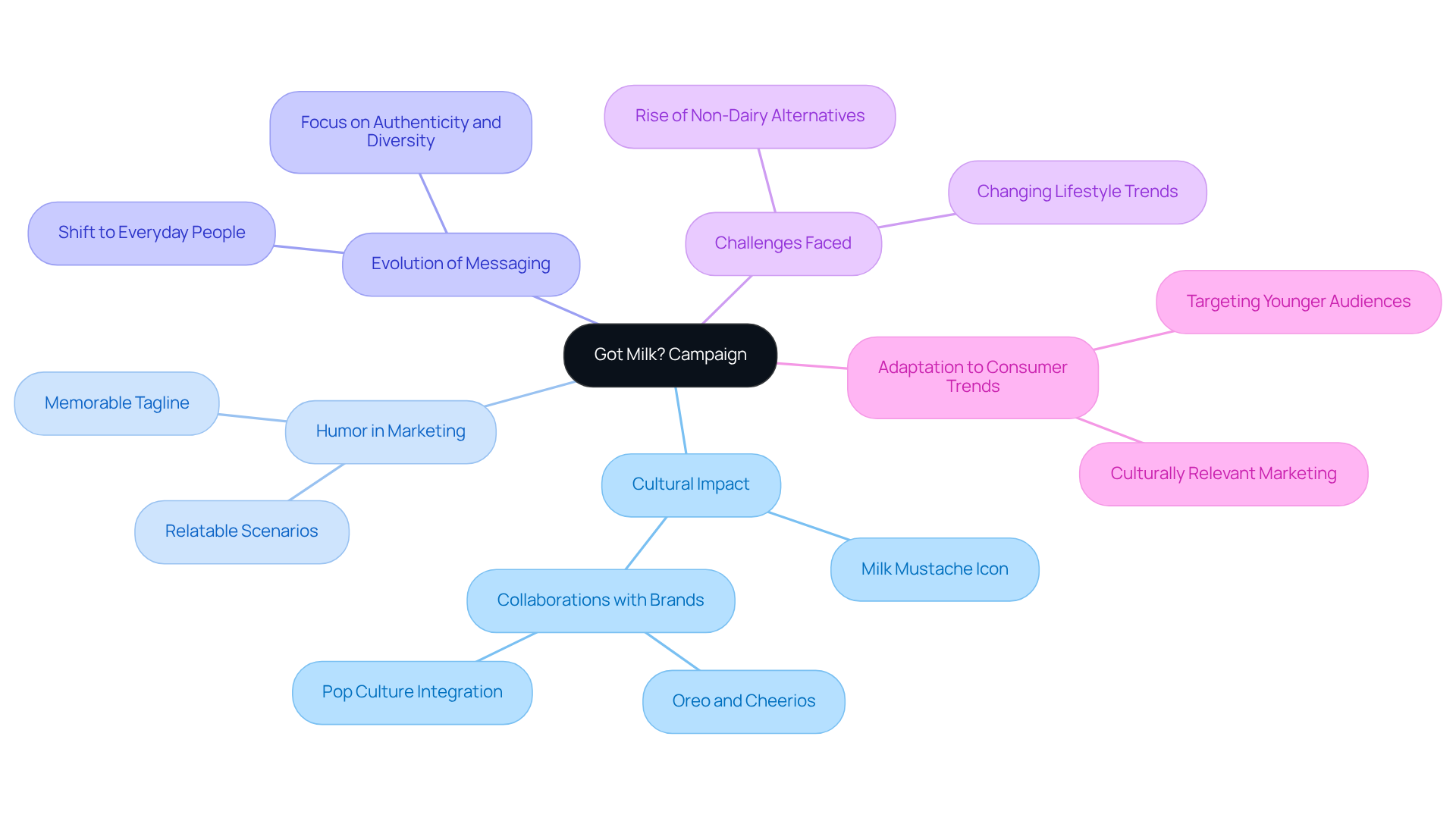
ALS Ice Bucket Challenge: A Viral Campaign That Raised Awareness and Funds
The ALS Ice Bucket Challenge emerged as a heartfelt response to the pressing issue of ALS, capturing widespread attention in 2014. Participants were invited to pour ice water over themselves and challenge others, all in the spirit of raising vital funds for ALS research. This innovative initiative generated an astonishing within just six weeks, representing a remarkable 3,500% increase over typical annual fundraising. More than that, it significantly raised awareness about this debilitating disease.
The challenge's viral nature was evident, with videos garnering over 10 billion views and more than 28 million people engaging with Ice Bucket Challenge content through posts, shares, and likes. This landmark moment in nonprofit marketing not only transformed traditional fundraising strategies but also sparked ongoing creative campaigns examples within the sector. Experts like Mark Schaefer have noted that the initiative's success stemmed from its genuine, visual, and enjoyable approach, paving the way for future efforts.
Moreover, the Ice Bucket Challenge serves as a testament to how campaigns examples of well-executed viral initiatives can lead to substantial financial contributions and progress in understanding critical health issues. Yet, it also faced scrutiny for being labeled as 'slacktivism,' raising important questions about the sustainability of such viral campaigns. Despite these challenges, the long-term effects have been profound, resulting in increased federal funding for ALS research and the discovery of new genes linked to ALS risk. This initiative not only fostered a sense of community but also highlighted the power of collective action in addressing significant health matters.
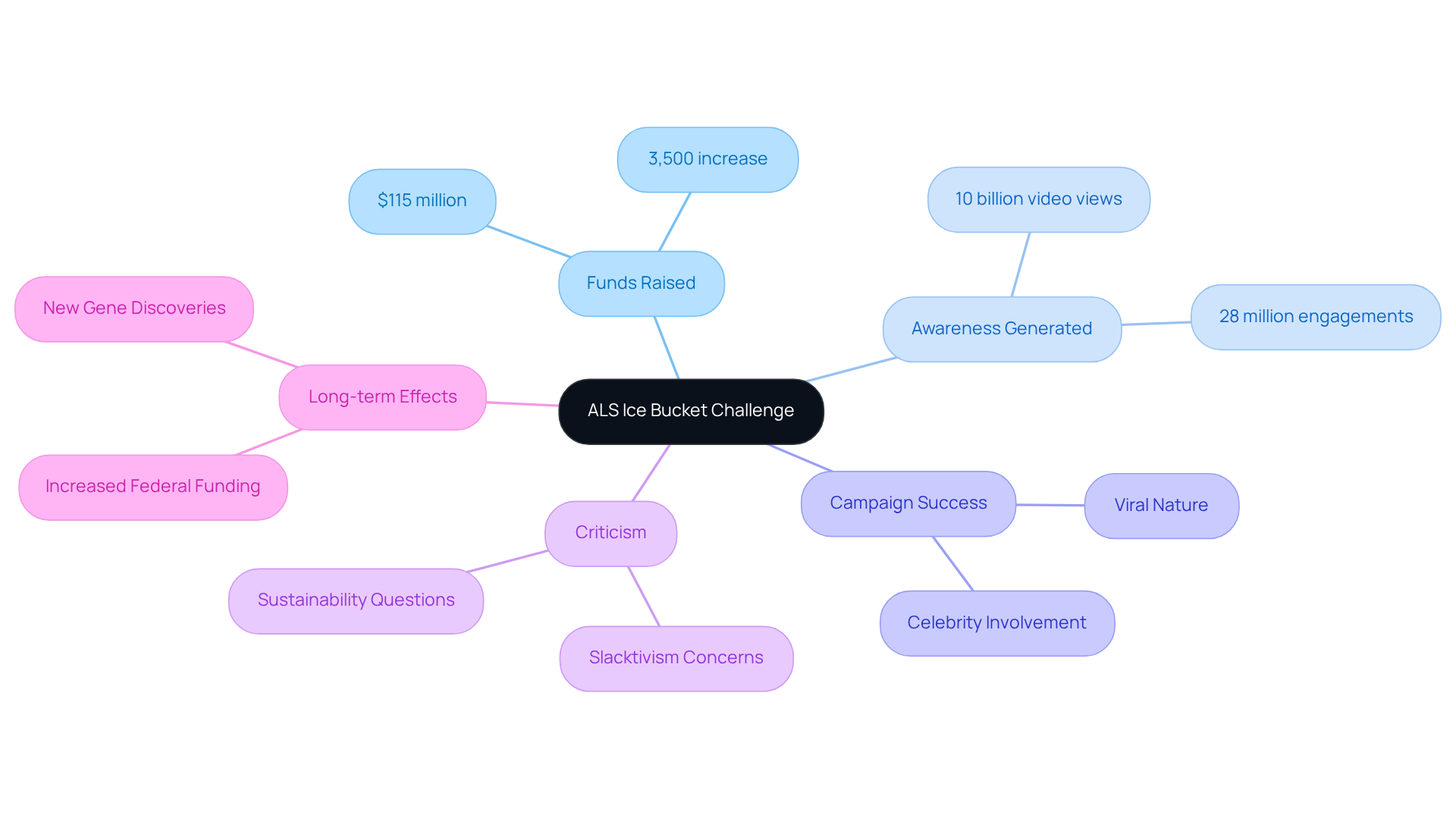
Patagonia: Don't Buy This Jacket Campaign That Promotes Sustainability
In a world where consumption often overshadows sustainability, Patagonia's 'Don't Buy This Jacket' initiative, launched in 2011, gently urged consumers to reconsider their purchasing habits and the environmental implications of their choices. By advocating for sustainability and responsible consumption, Patagonia emerged as a beacon of ethical marketing with numerous campaign examples.
Yvon Chouinard, the founder, poignantly remarked, "The initiative wasn’t just an advertisement—it was a ," highlighting how this initiative beautifully aligned with the company’s core principles. This heartfelt message resonated with environmentally conscious individuals, fostering loyalty and enhancing sales.
Following this campaign, Patagonia experienced a remarkable 30% surge in revenue the next year, illustrating that authenticity and purpose-driven marketing can indeed lead to commercial success. Moreover, a Deloitte statistic reveals that 69% of consumers wish for their companies to invest in sustainability efforts, underscoring the growing expectation for organizations to prioritize eco-friendliness.
This case exemplifies how campaign examples that harmonize marketing strategies with core values can reshape perceptions and encourage enduring growth.
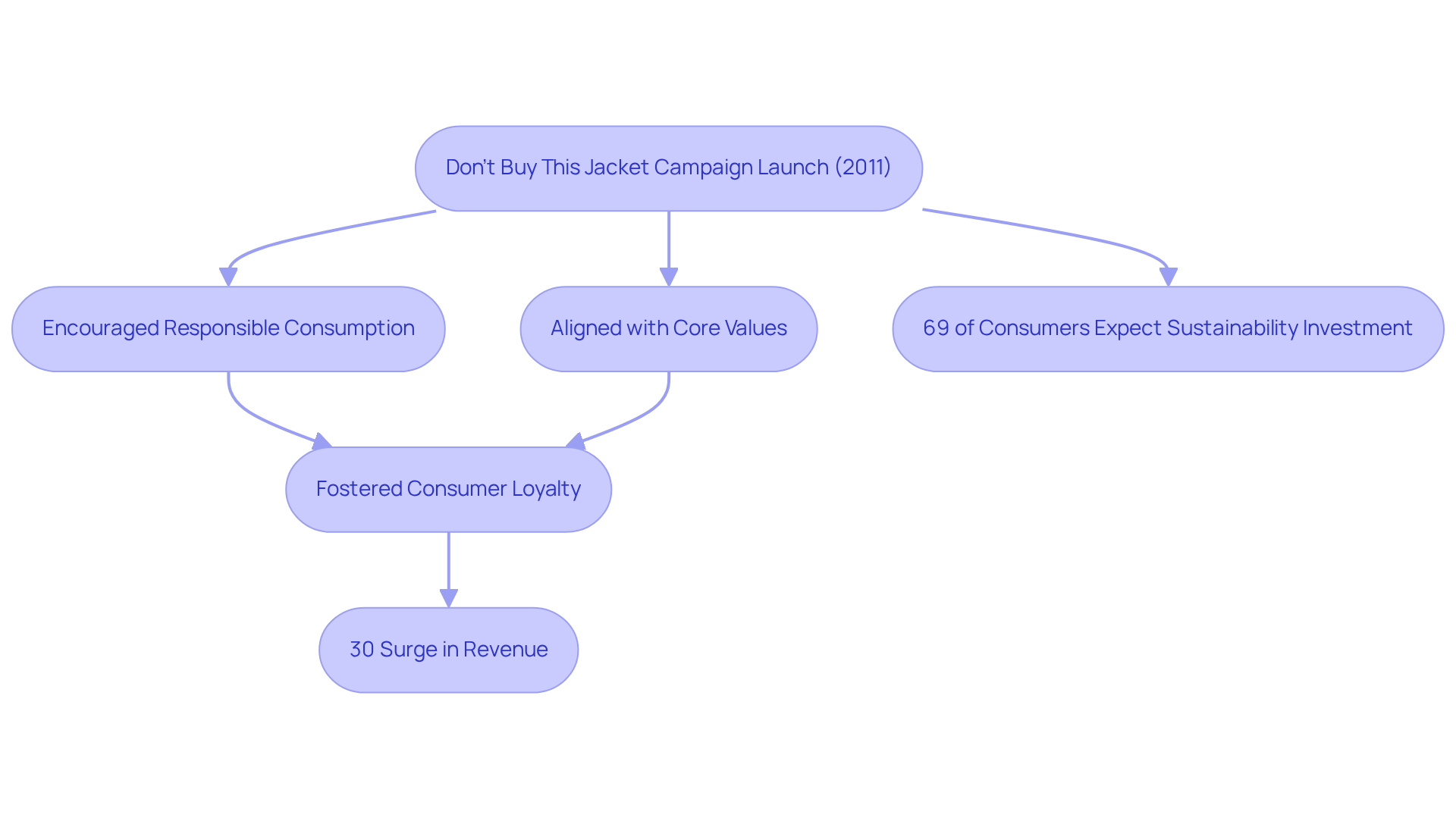
GoPro: Be a Hero Campaign That Leverages User-Generated Content
GoPro's 'Be a Hero' campaign serves as one of the notable campaign examples that highlight a common challenge many brands face: how to engage customers meaningfully. In a world where consumers often feel disconnected from brands, GoPro invites users to share their adventures captured with GoPro cameras. This initiative not only addresses the issue but transforms customers into passionate advocates, nurturing a vibrant community of enthusiasts who genuinely promote the brand. By showcasing authentic user experiences, GoPro amplifies its visibility and fosters deep customer loyalty.
The implications of this approach are profound. Companies that integrate user-generated content (UGC) into their marketing strategies are projected to thrive financially by 2025, as UGC significantly drives engagement and conversion rates. Remarkably, UGC is considered eight times more effective than influencer content in decision-making. This underscores the importance of harnessing the creativity and authenticity of customers in marketing efforts.
Moreover, 90% of consumers acknowledge that customer ratings and reviews influence their purchasing decisions. This statistic emphasizes how crucial UGC is in and building trust in products. GoPro's strategy illustrates how campaign examples that focus on fostering authentic relationships through UGC can lead to lasting loyalty and a more engaged customer base. As Kristen Wiley beautifully states, "Authenticity builds trust. And you can't get much more authentic than raw user-generated content." This sentiment resonates deeply, reminding us that genuine connections are at the heart of successful marketing.
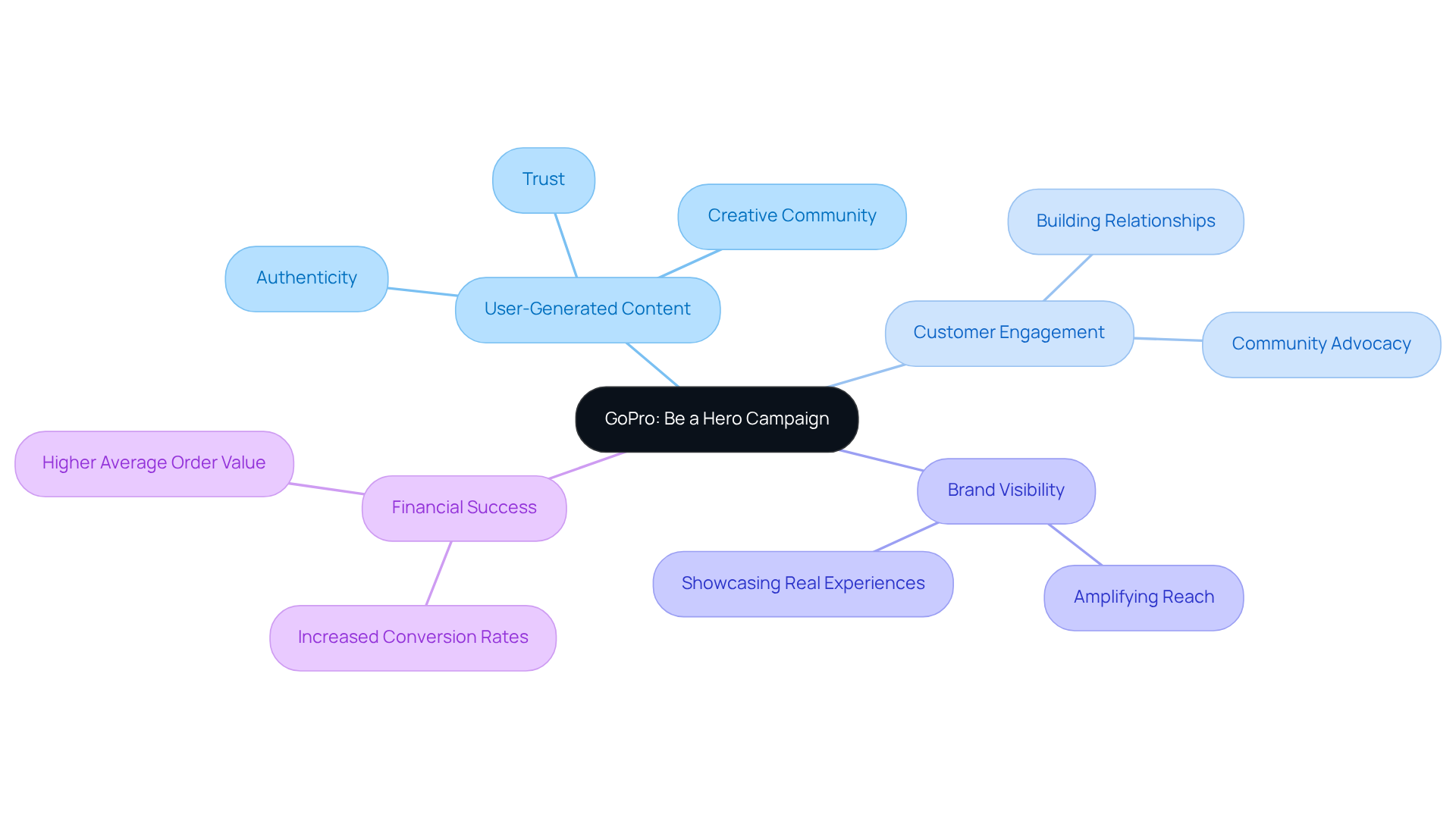
Apple: Shot on iPhone Campaign That Showcases User Creativity
In a world where creativity often feels overshadowed, many of us struggle to find the right platform to express ourselves. Apple’s ‘Shot on iPhone’ campaigns examples demonstrate a nurturing solution by inviting users to share their best photos taken with iPhones, effectively showcasing the remarkable capabilities of the device’s camera. By prominently featuring real user content, Apple cultivates authenticity and trust, encouraging potential customers to view the iPhone as a powerful tool for creativity.
This heartfelt approach not only enhances brand loyalty but also provides campaigns examples that illustrate the significant impact of user-generated content (UGC) in marketing. Statistics reveal that:
- 70% of buyers consider UGC reviews or ratings before making a purchase, highlighting how UGC significantly influences purchasing decisions related to iPhones.
- Initiatives that embrace UGC experience a 50% rise in engagement.
- UGC ads achieve four times greater click-through rates, underscoring the effectiveness of this strategy.
By leveraging user creativity, which makes 56% of consumers more likely to buy a product after seeing it featured in relatable UGC, Apple not only strengthens its brand image but also fosters a community of engaged users who feel valued and connected to the brand. This sense of belonging is what truly resonates, creating a where creativity can flourish.
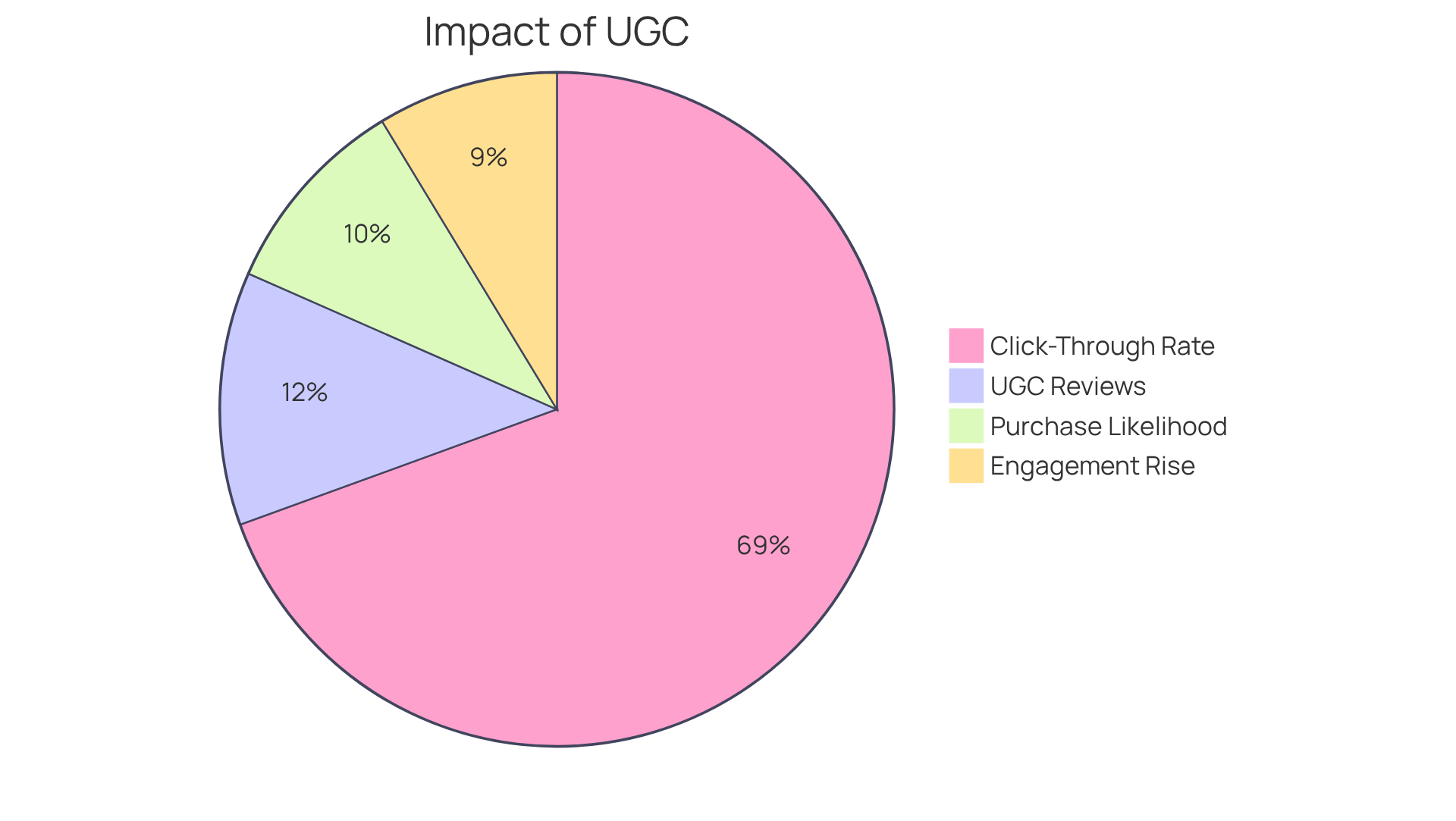
Airbnb: We Accept Campaign That Promotes Inclusivity and Diversity
In today's world, many brands struggle to connect with diverse audiences, often missing the mark on inclusivity. This gap not only alienates potential customers but also diminishes brand loyalty. The implications of this disconnect can be profound, as consumers increasingly seek and foster a sense of belonging.
Airbnb's 'We Accept' initiative, introduced in 2017, serves as one of the notable campaign examples that demonstrate how embracing inclusivity can transform branding strategies. By highlighting diverse hosts and guests, this campaign reinforced Airbnb's commitment to creating a welcoming environment for all individuals, regardless of their background. This initiative not only resonated with customers but also established Airbnb as a socially responsible entity, showcasing the effectiveness of purpose-driven marketing in enhancing loyalty.
Research indicates that inclusive advertising can lead to a 23-point increase in purchase intent, and companies with more inclusive practices experience 16.26% higher long-term sales performance. Moreover, two-thirds of Americans express that their social values influence their purchasing decisions, suggesting that shoppers increasingly prefer brands that represent their beliefs.
The 'We Accept' initiative is one of the campaign examples that exemplifies this trend, demonstrating that companies prioritizing inclusivity can significantly enhance their market perception and customer engagement. As noted, 'Inclusion was a key factor for 51% of customers overall,' emphasizing the critical role of inclusivity in branding strategies. Furthermore, 57% of consumers show greater loyalty to brands dedicated to addressing social inequities, highlighting the initiative's positive impact on consumer loyalty.
By embracing inclusivity, brands can not only connect with their audience but also foster a sense of community and support that resonates deeply with consumers.
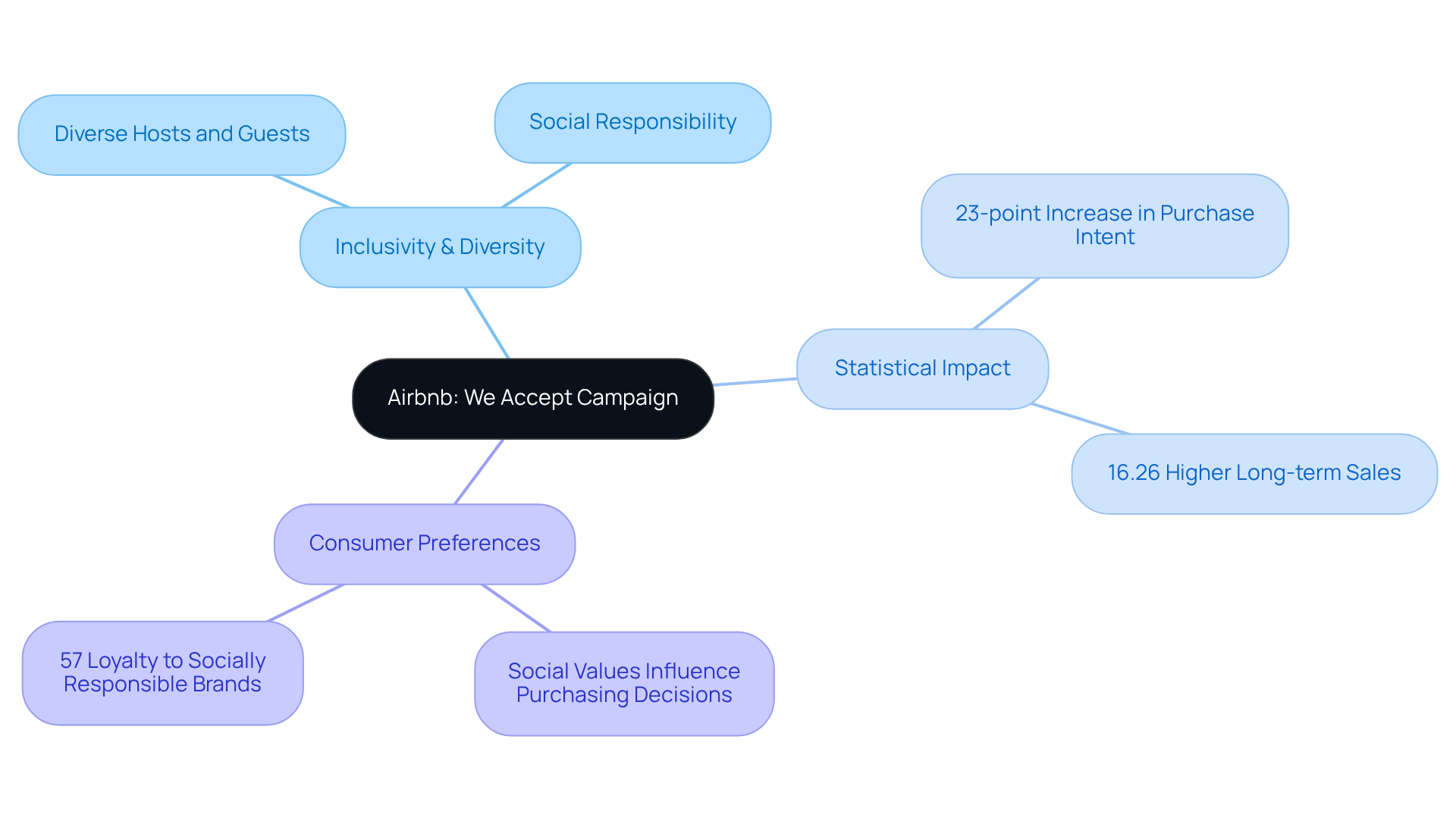
Spotify: Wrapped Campaign That Personalizes User Experience
Spotify's Wrapped initiative presents a relatable challenge for many users: the desire for recognition and connection through their listening habits. Each year, it offers a personalized overview of users' listening behaviors, showcasing their favorite songs, artists, and genres. This captivating experience not only encourages users to across social media but also fosters a vibrant community among Spotify users.
In 2024, over 10.5 million users shared their Wrapped summaries directly from the app, a heartwarming rise from 9 million in 2023 and 7 million in 2022, reflecting the initiative's immense popularity. By harnessing the power of personalization, Spotify significantly enhances user engagement and brand loyalty, illustrating how tailored marketing experiences can transform customer relationships.
The introduction of new features like 'Listening Personality' and 'Audio Day' in 2022 has further enriched user engagement. The initiative's ability to turn individual listening data into a collective story cultivates a sense of belonging, making users feel appreciated and understood. This strategy exemplifies the effectiveness of campaigns examples in personalized marketing, as it not only boosts user satisfaction but also drives retention, with Spotify reporting a 40% increase in app engagement during Wrapped 2024 compared to 37% in 2023 and 32% in 2022.
However, the initiative has faced some backlash regarding perceived inaccuracies and biases towards mainstream artists, highlighting the importance of transparency in data-driven personalization. As Spotify continues to evolve, it remains crucial to listen to users' concerns and refine the experience, ensuring that every listener feels valued and part of a caring community.
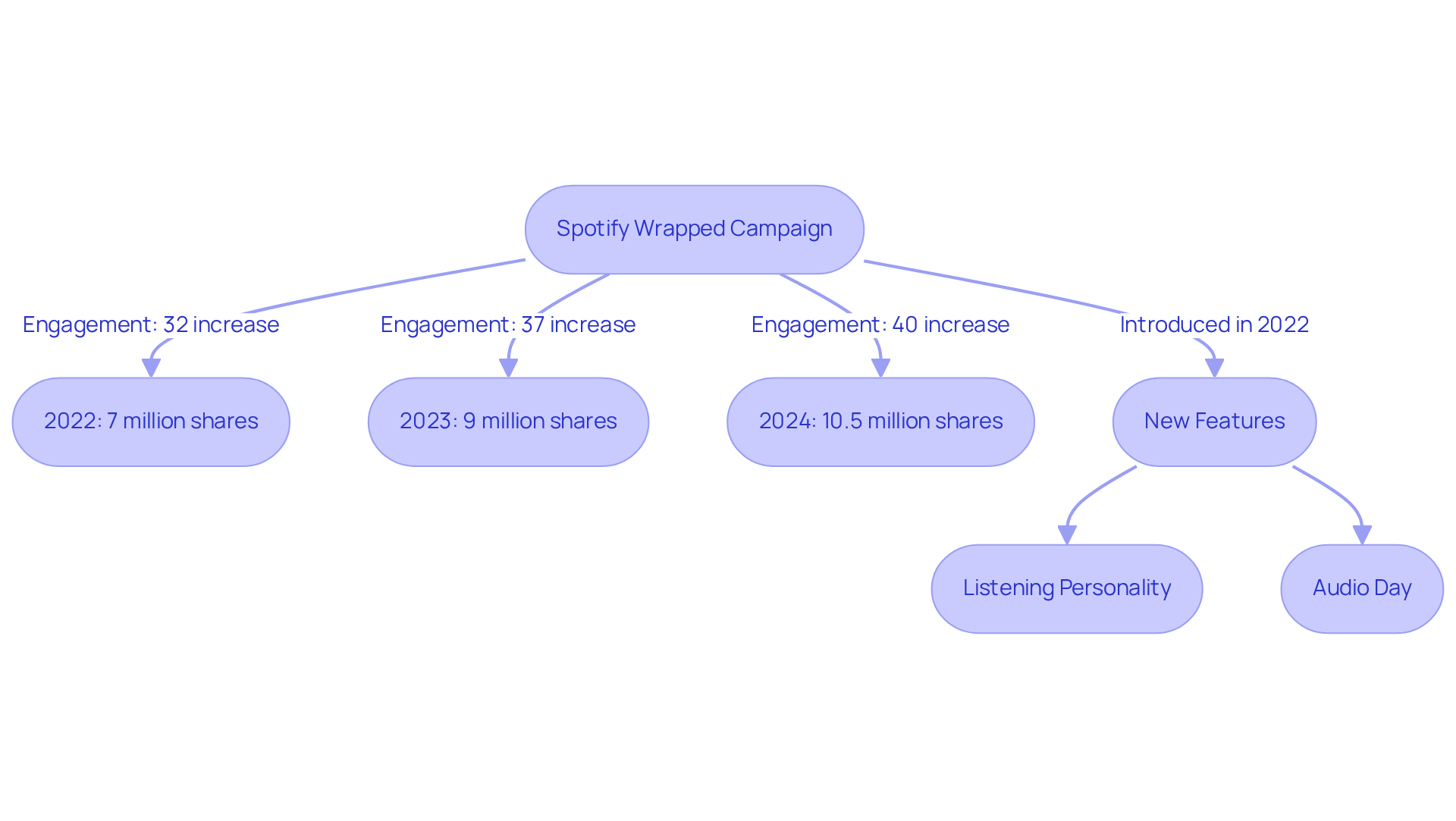
McDonald's: I'm Lovin' It Campaign That Resonates with Consumers
Launched in 2003, McDonald's 'I'm Lovin' It' initiative is often cited among the most iconic campaigns examples in advertising history. The jingle, known for its catchy melody and uplifting message, has truly resonated with audiences, reinforcing McDonald's image as a cherished fast-food brand. This initiative serves as one of the campaigns examples that highlight the power of consistent branding, as it has adeptly adapted to evolving consumer preferences while staying true to its core message.
Research shows that consistent branding can boost revenue by as much as 33%, and McDonald's has seen impressive success from this approach. After the campaigns examples were launched, the company experienced an astonishing $680 million increase in U.S. sales and over $1.8 billion in global sales within its first year. This serves as a testament to how a can profoundly influence consumer behavior and drive sales.
The jingle not only raises product awareness but also fosters emotional connections, making people feel at home no matter where they are. In an era when product loyalty is crucial, McDonald's 'I'm Lovin' It' stands out as one of the notable campaigns examples demonstrating how effective marketing can nurture lasting customer relationships and promote ongoing business growth.
As noted, 'That level of recognition is marketing gold,' underscoring the initiative's significant impact on customer awareness and loyalty.
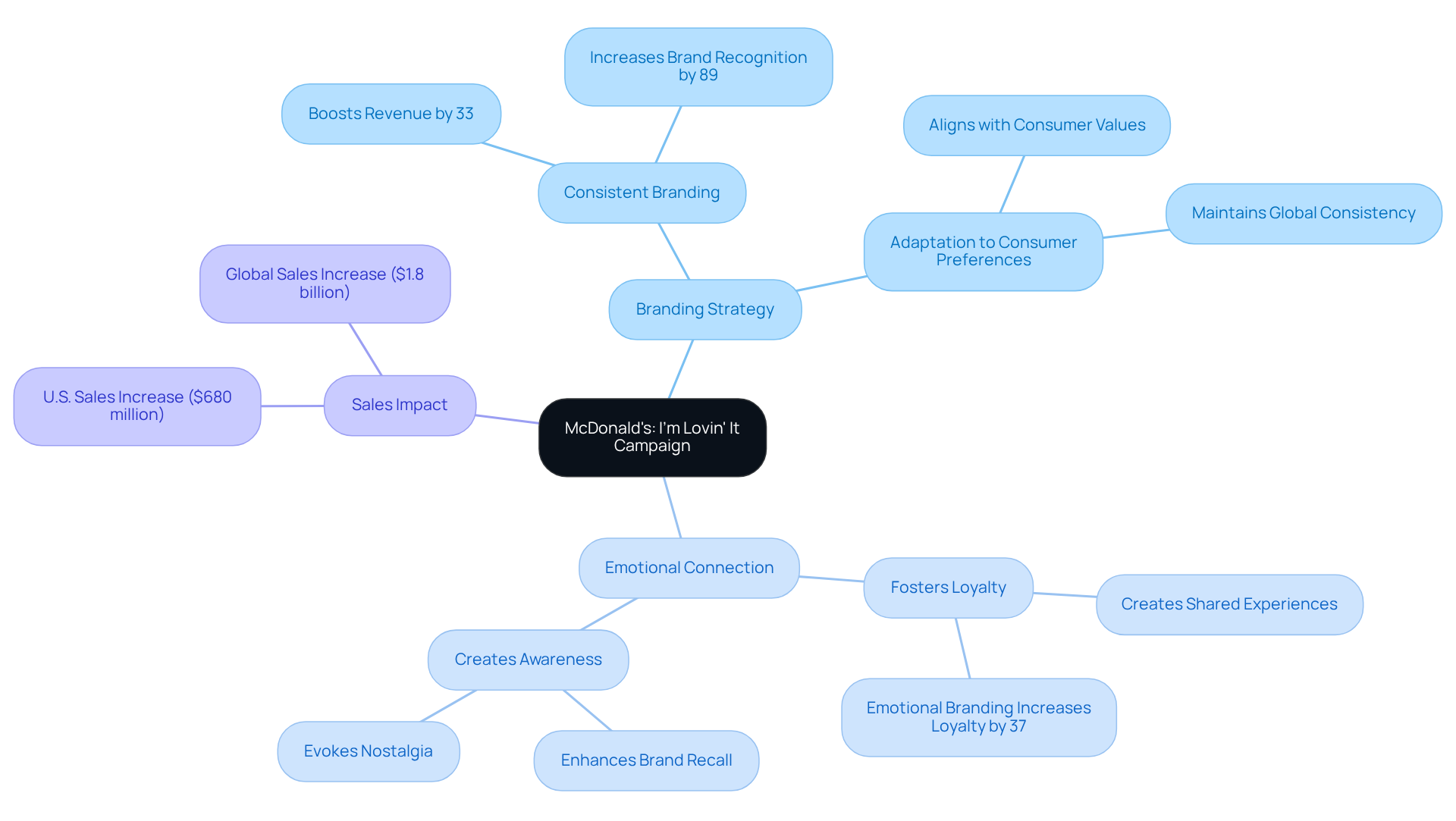
Heineken: Worlds Apart Campaign That Tackles Social Issues
Heineken's 'Worlds Apart' initiative, launched in 2017, sought to address a pressing societal divide by bringing together individuals with opposing views through a heartfelt social experiment. In this initiative, participants engaged in meaningful conversations over beer, fostering an environment of open dialogue and understanding. This effort not only underscored Heineken's but also reinforced its identity as a brand that genuinely cares about its consumers and their communities.
The initiative's impact was significant, with:
- 91% of sentiments being favorable
- A remarkable increase in customer loyalty, as 80% of respondents felt that Heineken unites individuals
By tackling urgent social issues, Heineken effectively showcased the strength of purpose-driven marketing through various campaign examples, positioning itself as a leader in socially responsible branding. The initiative garnered over 50.5 million views, illustrating its resonance with audiences and the effectiveness of its message in promoting unity and empathy in a polarized world.

Taco Bell: Hotel Taco Bell Campaign That Generated Buzz and Engagement
Taco Bell's 'Hotel Taco Bell' initiative, introduced in 2019, is one of the notable campaign examples that addressed a common challenge many brands face: how to truly connect with customers. In a world where consumers often feel distant from brands, Taco Bell transformed a hotel into a fully immersive Taco Bell-themed experience, providing a solution that resonates deeply. Guests were treated to exclusive menu items and unique branding elements, fostering a memorable atmosphere that truly engaged fans.
This , which is among the notable campaign examples, not only generated significant buzz but also attracted extensive media attention, reinforcing Taco Bell's image as a fun and creative entity. It beautifully illustrates the power of experiential marketing, as studies show that 9 out of 10 individuals are more likely to buy from a brand after engaging in such experiences.
By nurturing genuine relationships through distinctive campaign examples, Taco Bell effectively involved consumers, leading to heightened loyalty and support. In fact, 77% of attendees reported increased confidence in a company after participating in an experiential initiative, highlighting the lasting impact of these immersive experiences.
This initiative serves as a reminder of how meaningful connections can foster community and loyalty, inviting us all to reflect on our own experiences with brands that truly care.

Nike: Find Your Greatness Campaign That Encourages Personal Achievement
Nike's 'Find Your Greatness' initiative, launched in 2012, addresses a common struggle: the feeling that greatness is out of reach for many. This initiative encourages individuals to pursue their unique ambitions, no matter their backgrounds. It emerged as a heartfelt response to Nike losing its Olympics sponsorship to Adidas, pushing the brand to connect with customers in a more meaningful way. By highlighting everyday athletes achieving remarkable feats, Nike inspires all of us to realize our potential and chase our personal goals. This uplifting message resonates deeply, reinforcing Nike's dedication to inclusivity and personal achievement.
The impact of this initiative on consumer motivation is profound. It fosters a sense of empowerment and connection, positioning Nike as a brand that champions the journey of self-improvement. Through and relatable figures, Nike conveys that greatness isn't just for elite athletes; it's attainable for everyone. Notably, during the Olympics, Nike gained 57,000 new social media followers, while Adidas attracted just 12,000. This highlights the effectiveness of the strategy in enhancing brand loyalty and consumer engagement.
The hashtag #findyourgreatness has become an unofficial mantra, illustrating the cultural significance of various campaigns examples. It invites everyone to share their experiences and aspirations, creating a community of support and encouragement. In this way, Nike not only promotes its brand but also nurtures a collective journey toward greatness.

Always: Like a Girl Campaign That Empowers Women
Launched in 2014, Always' '#LikeAGirl' initiative aimed to transform the phrase 'like a girl' from a derogatory term into a powerful statement of strength. This initiative highlights the experiences of young girls and women confidently showcasing their abilities, sparking vital discussions about gender equality and self-worth.
It's essential to recognize how this empowering narrative resonates deeply with audiences and reinforces Always' commitment to supporting women and girls. The initiative achieved remarkable success, generating over 4.4 billion media impressions and elevating positive sentiment to 96% within just three months. It was even recognized as the number two viral video globally, a testament to its profound impact and reach.
This initiative beautifully exemplifies campaigns examples that show how purpose-driven marketing can transform brand perception and foster a culture of empowerment. As Emma Watson wisely noted, gender equality liberates both women and men from limiting stereotypes, a principle that aligns seamlessly with the initiative's goals.
Furthermore, the initiative led to a significant increase in social media engagement, with Always's Twitter followers tripling and YouTube subscribers surging by 4,339%. The UN also acknowledged the initiative's influence on female empowerment, emphasizing its broader significance within the framework of gender equality campaigns examples. Together, these achievements illustrate the collective journey towards a more .

Pepsi: The Pepsi Challenge Campaign That Engaged Consumers
Launched in 1975, the Pepsi Challenge is one of the notable campaign examples as it was an invitation for participants to engage in blind taste tests that compared Pepsi and Coca-Cola. This innovative initiative sparked excitement and positioned Pepsi as a serious contender in the beverage market. By inviting people to share in the tasting experience, Pepsi fostered a sense of loyalty and involvement, demonstrating how experiential marketing can enhance brand recognition.
The campaign's success was evident, as Pepsi's market share increased from 6% to 14% in heavily promoted regions, with a 20% improvement in product perception among young adults, according to a study by the Harvard Business Review. This strategic approach also included like Kroger and Safeway, which helped drive participation through special displays and promotional discounts.
Pepsi's bold decision to challenge Coca-Cola directly not only established it as a viable alternative but also created campaign examples that set a standard for future interactive marketing strategies. This campaign illustrates the profound impact that consumer participation can have on shaping brand identity, reminding us that engaging with our audience can lead to lasting connections.

Conclusion
The exploration of transformative branding campaigns reveals a significant challenge: the disconnect between brands and consumers. This gap can lead to diminished brand loyalty and a lack of meaningful engagement. However, innovative marketing strategies offer a compassionate solution. Each campaign discussed exemplifies how brands can connect deeply with their audiences by addressing real-world issues, promoting inclusivity, and fostering community engagement. From RNO1's focus on personalized digital experiences to Dove's challenge of conventional beauty standards, these examples underscore the importance of authenticity and emotional resonance in branding.
Key insights from the campaigns illustrate that successful marketing is not merely about selling products; it's about creating meaningful connections. Initiatives like Nike's 'Just Do It' and Coca-Cola's 'Share a Coke' show how brands can inspire action and engagement, leading to increased loyalty and sales. Similarly, Patagonia's commitment to sustainability and the ALS Ice Bucket Challenge's viral success highlight the power of purpose-driven marketing in shaping consumer behavior and driving impactful change.
As brands continue to navigate an evolving marketplace, the lessons drawn from these campaigns emphasize the necessity of aligning marketing strategies with consumer values and societal trends. By prioritizing authenticity, inclusivity, and emotional engagement, brands can not only enhance their market presence but also foster a sense of belonging among consumers. This approach not only strengthens brand loyalty but also paves the way for sustainable growth in a competitive landscape. Together, we can create a marketing environment that nurtures connections and supports the shared journey of growth.
Frequently Asked Questions
What is RNO1, and how does it help businesses?
RNO1 specializes in creating radical digital experiences tailored for modern businesses. They offer innovative solutions like subscription models—Revolve, Retrn, and Ryde—that empower companies to achieve sustainable growth by enhancing customer engagement and integrating feedback.
What are the benefits of subscription models according to RNO1?
Subscription models can lead to customer retention rates as high as 90%, compared to the typical 30-40% in traditional e-commerce. This fosters customer loyalty and provides reliable revenue streams, nurturing long-term relationships with clients.
How does RNO1 stay relevant in the evolving digital landscape?
RNO1 stays ahead of trends by emphasizing personalization and community involvement, which reflects the growing demand for customized interactions. They focus on authenticity and emotional connections to help companies exceed consumer expectations.
What is Dove's Real Beauty campaign, and what impact did it have?
Dove's Real Beauty initiative, launched in 2004, showcased authentic women of diverse shapes and sizes to challenge narrow beauty standards. It significantly enhanced brand loyalty, with 71% of women reporting a more favorable perception of Dove, and contributed to sales growth from $2.5 billion to over $4 billion within three years.
How did Dove's campaign influence social media engagement?
The Real Beauty campaign achieved a 700% increase in social media engagement, showcasing its effectiveness in building connections and fostering community among consumers.
What is the significance of Nike's 'Just Do It' campaign?
Nike's 'Just Do It' campaign, launched in 1988, has become a cultural phenomenon that motivates and empowers individuals. It has cultivated a dedicated customer base and established a standard for effective branding, resulting in a surge in global sales from $877 million to $9.2 billion within ten years.
What impact did Coca-Cola's 'Share a Coke' campaign have on customer engagement?
Coca-Cola's 'Share a Coke' initiative personalized customer interaction by replacing its logo with popular names on bottles, fostering connections. This campaign led to a 2% increase in U.S. sales after a decade of decline and generated significant social media engagement with over 500,000 photos shared under the hashtag #ShareaCoke.
How did Old Spice's campaign change brand perception?
Old Spice's 'The Man Your Man Could Smell Like' campaign, launched in 2010, revitalized the brand's image by using humor and targeting women who influence men's grooming purchases. This strategy resulted in a 107% increase in sales and transformed Old Spice from a 'dad product' to a modern, desirable option.




